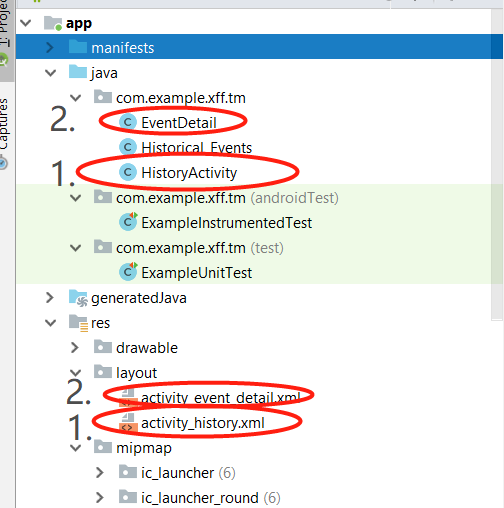Android Studio click the button to jump to a new interface
Problem description
First, we have two Java files and the XML files bound to them. Here, take history activity.Java, activity_history.xml and event detail.Java, activity_event_detail.xml as examples. We want to add a button in the history activity interface, and click to jump to the event detail interface.
Add button for HistoryActivity interface
In its corresponding activity_history.xml:
<?xml version="1.0" encoding="utf-8"?>
<android.support.constraint.ConstraintLayout xmlns:android="http://schemas.android.com/apk/res/android"
xmlns:app="http://schemas.android.com/apk/res-auto"
xmlns:tools="http://schemas.android.com/tools"
android:layout_width="match_parent"
android:layout_height="match_parent"
tools:context=".HistoryActivity">
<Button
android:id="@+id/History"
android:layout_width="wrap_content"
android:layout_height="wrap_content"
android:text="Historical Event"
android:layout_alignParentLeft="true"
android:layout_alignParentStart="true"/>
</android.support.constraint.ConstraintLayout>
We use the android:id="@+id/History" statement to say that the button's ID is set to History, which is used later when setting the click event.
Add a click event for the History button
In HistoryActivity.java:
package com.example.xff.tm;
import android.support.v7.app.AppCompatActivity;
import android.os.Bundle;
import android.view.View;
import android.view.View.OnClickListener;
import android.content.Intent;
import android.widget.Button;
import android.widget.*;
public class HistoryActivity extends AppCompatActivity {
Button button = null;
@Override
protected void onCreate(Bundle savedInstanceState) {
super.onCreate(savedInstanceState);
setContentView(R.layout.activity_history);
button = (Button)findViewById(R.id.History);
button.setOnClickListener(new View.OnClickListener() {
@Override
public void onClick(View v) {
Intent intent = new Intent();
intent.setClass(HistoryActivity.this,EventDetail.class);
startActivity(intent);
}
});
}
}
Find the corresponding button through the id of the previously defined button, and set click listening for it. When a click event occurs, jump through Intent.
#Add activity in manifests - > androidmanifest.xml (this step is usually generated automatically after adding click event, which can be checked)
<?xml version="1.0" encoding="utf-8"?>
<manifest xmlns:android="http://schemas.android.com/apk/res/android"
package="com.example.xff.tm">
<application
android:allowBackup="true"
android:icon="@mipmap/ic_launcher"
android:label="@string/app_name"
android:roundIcon="@mipmap/ic_launcher_round"
android:supportsRtl="true"
android:theme="@style/AppTheme">
<activity android:name=".HistoryActivity">
<intent-filter>
<action android:name="android.intent.action.MAIN" />
<category android:name="android.intent.category.LAUNCHER" />
</intent-filter>
</activity>
<activity android:name=".EventDetail"></activity>
</application>
</manifest>
EventDetail.java,activity_event_detail.xml
As the jump interface, these two files only need to complete their own functions:
EventDetail.java:
package com.example.xff.tm;
import android.support.v7.app.AppCompatActivity;
import android.os.Bundle;
public class EventDetail extends AppCompatActivity {
@Override
protected void onCreate(Bundle savedInstanceState) {
super.onCreate(savedInstanceState);
setContentView(R.layout.activity_event_detail);
}
}
activity_event_detail.xml:
<?xml version="1.0" encoding="utf-8"?>
<android.support.constraint.ConstraintLayout xmlns:android="http://schemas.android.com/apk/res/android"
xmlns:app="http://schemas.android.com/apk/res-auto"
xmlns:tools="http://schemas.android.com/tools"
android:layout_width="match_parent"
android:layout_height="match_parent"
tools:context=".EventDetail">
</android.support.constraint.ConstraintLayout>